Sample Assignment on Health PDF
VerifiedAdded on 2021/05/30
|10
|2689
|47
AI Summary
Contribute Materials
Your contribution can guide someone’s learning journey. Share your
documents today.
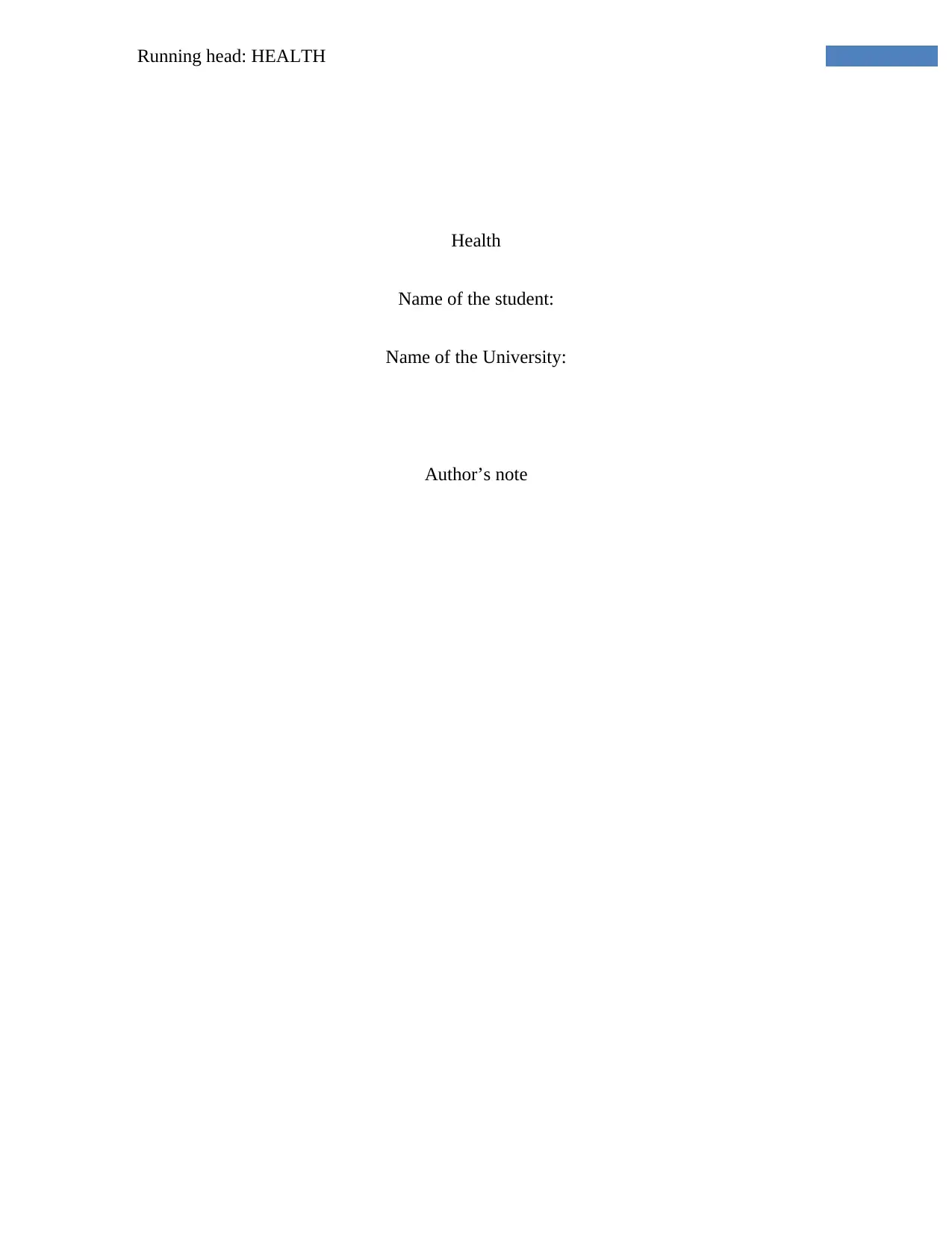
Running head: HEALTH
Health
Name of the student:
Name of the University:
Author’s note
Health
Name of the student:
Name of the University:
Author’s note
Secure Best Marks with AI Grader
Need help grading? Try our AI Grader for instant feedback on your assignments.
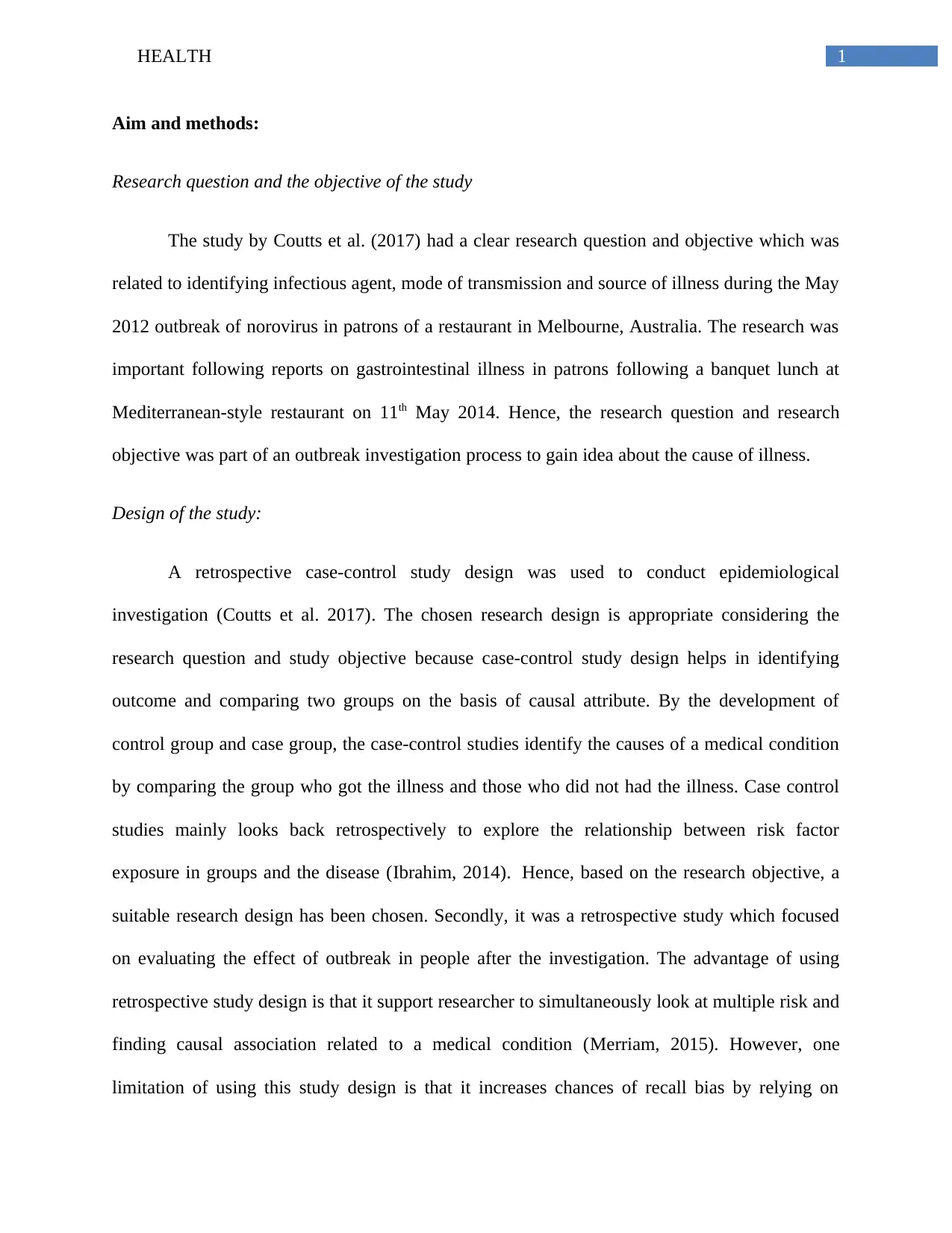
1HEALTH
Aim and methods:
Research question and the objective of the study
The study by Coutts et al. (2017) had a clear research question and objective which was
related to identifying infectious agent, mode of transmission and source of illness during the May
2012 outbreak of norovirus in patrons of a restaurant in Melbourne, Australia. The research was
important following reports on gastrointestinal illness in patrons following a banquet lunch at
Mediterranean-style restaurant on 11th May 2014. Hence, the research question and research
objective was part of an outbreak investigation process to gain idea about the cause of illness.
Design of the study:
A retrospective case-control study design was used to conduct epidemiological
investigation (Coutts et al. 2017). The chosen research design is appropriate considering the
research question and study objective because case-control study design helps in identifying
outcome and comparing two groups on the basis of causal attribute. By the development of
control group and case group, the case-control studies identify the causes of a medical condition
by comparing the group who got the illness and those who did not had the illness. Case control
studies mainly looks back retrospectively to explore the relationship between risk factor
exposure in groups and the disease (Ibrahim, 2014). Hence, based on the research objective, a
suitable research design has been chosen. Secondly, it was a retrospective study which focused
on evaluating the effect of outbreak in people after the investigation. The advantage of using
retrospective study design is that it support researcher to simultaneously look at multiple risk and
finding causal association related to a medical condition (Merriam, 2015). However, one
limitation of using this study design is that it increases chances of recall bias by relying on
Aim and methods:
Research question and the objective of the study
The study by Coutts et al. (2017) had a clear research question and objective which was
related to identifying infectious agent, mode of transmission and source of illness during the May
2012 outbreak of norovirus in patrons of a restaurant in Melbourne, Australia. The research was
important following reports on gastrointestinal illness in patrons following a banquet lunch at
Mediterranean-style restaurant on 11th May 2014. Hence, the research question and research
objective was part of an outbreak investigation process to gain idea about the cause of illness.
Design of the study:
A retrospective case-control study design was used to conduct epidemiological
investigation (Coutts et al. 2017). The chosen research design is appropriate considering the
research question and study objective because case-control study design helps in identifying
outcome and comparing two groups on the basis of causal attribute. By the development of
control group and case group, the case-control studies identify the causes of a medical condition
by comparing the group who got the illness and those who did not had the illness. Case control
studies mainly looks back retrospectively to explore the relationship between risk factor
exposure in groups and the disease (Ibrahim, 2014). Hence, based on the research objective, a
suitable research design has been chosen. Secondly, it was a retrospective study which focused
on evaluating the effect of outbreak in people after the investigation. The advantage of using
retrospective study design is that it support researcher to simultaneously look at multiple risk and
finding causal association related to a medical condition (Merriam, 2015). However, one
limitation of using this study design is that it increases chances of recall bias by relying on

2HEALTH
people’s memory and experience to establish causal association. Since, the restaurant had
number of food choices, the likelihood of recall bias is even more high.
Coutts et al. (2017) recruited participants from the restaurant’s booking list and phone
interview by the use of structured questionnaire was used to collect data from participants. The
questionnaires for the interview were related to demographic, illness and food exposure data.
Coutts et al. (2017) used effective method to define case group. For example, case group
included those people who ate food at the restaurant and developed symptoms of vomiting, fever,
nausea and headache within 24 to 48 hours. The control group included those people who did not
meet the case definition criteria. Hence, this process of sample recruitment and classification of
groups enhances the credibility of the research work. Symptoms of gastroenteritis were the main
outcome measure for the study as the study was investigating about norovirus outbreak in
restaurant of Australia. However, one limitation found in outcome measurement was that it did
not used any practical method to detect norovirus in food samples. Although food handlers were
questioned regarding presence of gastroenteritis symptom, however the possibility of norovirus
contamination among food handlers was ignored. This limitation may influence the validity of
research evidence.
Key results:
A total of 46 cases ad 49 controls were enrolled for the research. The findings of the
study revealed significant association between illness and consumption of grain salad and
beetroot dip. This was confirmed because almost 98% of the case group recalled eating the grain
salad at the restaurant. Furthermore, the interview with staffs regarding preparation of grain salad
people’s memory and experience to establish causal association. Since, the restaurant had
number of food choices, the likelihood of recall bias is even more high.
Coutts et al. (2017) recruited participants from the restaurant’s booking list and phone
interview by the use of structured questionnaire was used to collect data from participants. The
questionnaires for the interview were related to demographic, illness and food exposure data.
Coutts et al. (2017) used effective method to define case group. For example, case group
included those people who ate food at the restaurant and developed symptoms of vomiting, fever,
nausea and headache within 24 to 48 hours. The control group included those people who did not
meet the case definition criteria. Hence, this process of sample recruitment and classification of
groups enhances the credibility of the research work. Symptoms of gastroenteritis were the main
outcome measure for the study as the study was investigating about norovirus outbreak in
restaurant of Australia. However, one limitation found in outcome measurement was that it did
not used any practical method to detect norovirus in food samples. Although food handlers were
questioned regarding presence of gastroenteritis symptom, however the possibility of norovirus
contamination among food handlers was ignored. This limitation may influence the validity of
research evidence.
Key results:
A total of 46 cases ad 49 controls were enrolled for the research. The findings of the
study revealed significant association between illness and consumption of grain salad and
beetroot dip. This was confirmed because almost 98% of the case group recalled eating the grain
salad at the restaurant. Furthermore, the interview with staffs regarding preparation of grain salad
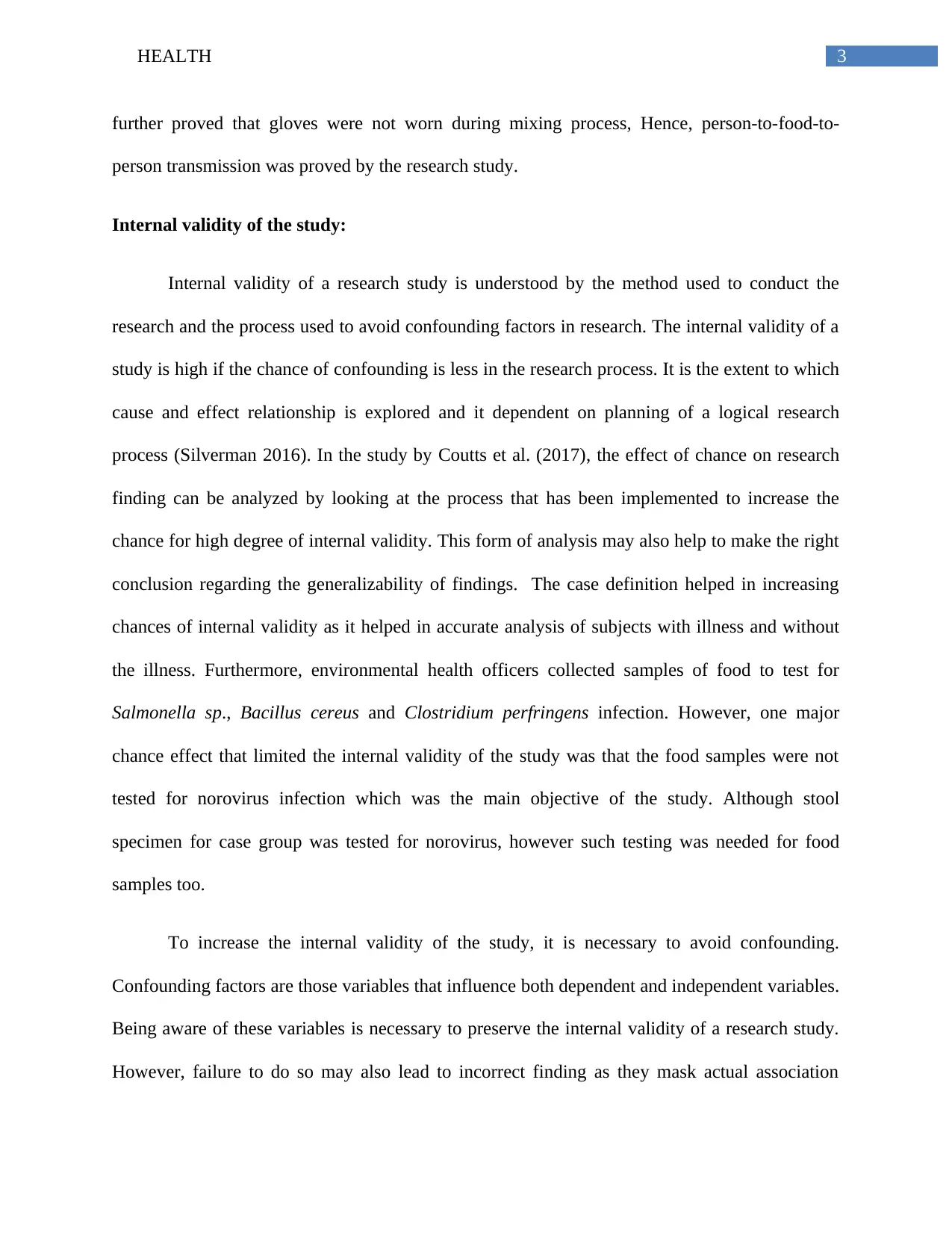
3HEALTH
further proved that gloves were not worn during mixing process, Hence, person-to-food-to-
person transmission was proved by the research study.
Internal validity of the study:
Internal validity of a research study is understood by the method used to conduct the
research and the process used to avoid confounding factors in research. The internal validity of a
study is high if the chance of confounding is less in the research process. It is the extent to which
cause and effect relationship is explored and it dependent on planning of a logical research
process (Silverman 2016). In the study by Coutts et al. (2017), the effect of chance on research
finding can be analyzed by looking at the process that has been implemented to increase the
chance for high degree of internal validity. This form of analysis may also help to make the right
conclusion regarding the generalizability of findings. The case definition helped in increasing
chances of internal validity as it helped in accurate analysis of subjects with illness and without
the illness. Furthermore, environmental health officers collected samples of food to test for
Salmonella sp., Bacillus cereus and Clostridium perfringens infection. However, one major
chance effect that limited the internal validity of the study was that the food samples were not
tested for norovirus infection which was the main objective of the study. Although stool
specimen for case group was tested for norovirus, however such testing was needed for food
samples too.
To increase the internal validity of the study, it is necessary to avoid confounding.
Confounding factors are those variables that influence both dependent and independent variables.
Being aware of these variables is necessary to preserve the internal validity of a research study.
However, failure to do so may also lead to incorrect finding as they mask actual association
further proved that gloves were not worn during mixing process, Hence, person-to-food-to-
person transmission was proved by the research study.
Internal validity of the study:
Internal validity of a research study is understood by the method used to conduct the
research and the process used to avoid confounding factors in research. The internal validity of a
study is high if the chance of confounding is less in the research process. It is the extent to which
cause and effect relationship is explored and it dependent on planning of a logical research
process (Silverman 2016). In the study by Coutts et al. (2017), the effect of chance on research
finding can be analyzed by looking at the process that has been implemented to increase the
chance for high degree of internal validity. This form of analysis may also help to make the right
conclusion regarding the generalizability of findings. The case definition helped in increasing
chances of internal validity as it helped in accurate analysis of subjects with illness and without
the illness. Furthermore, environmental health officers collected samples of food to test for
Salmonella sp., Bacillus cereus and Clostridium perfringens infection. However, one major
chance effect that limited the internal validity of the study was that the food samples were not
tested for norovirus infection which was the main objective of the study. Although stool
specimen for case group was tested for norovirus, however such testing was needed for food
samples too.
To increase the internal validity of the study, it is necessary to avoid confounding.
Confounding factors are those variables that influence both dependent and independent variables.
Being aware of these variables is necessary to preserve the internal validity of a research study.
However, failure to do so may also lead to incorrect finding as they mask actual association
Paraphrase This Document
Need a fresh take? Get an instant paraphrase of this document with our AI Paraphraser
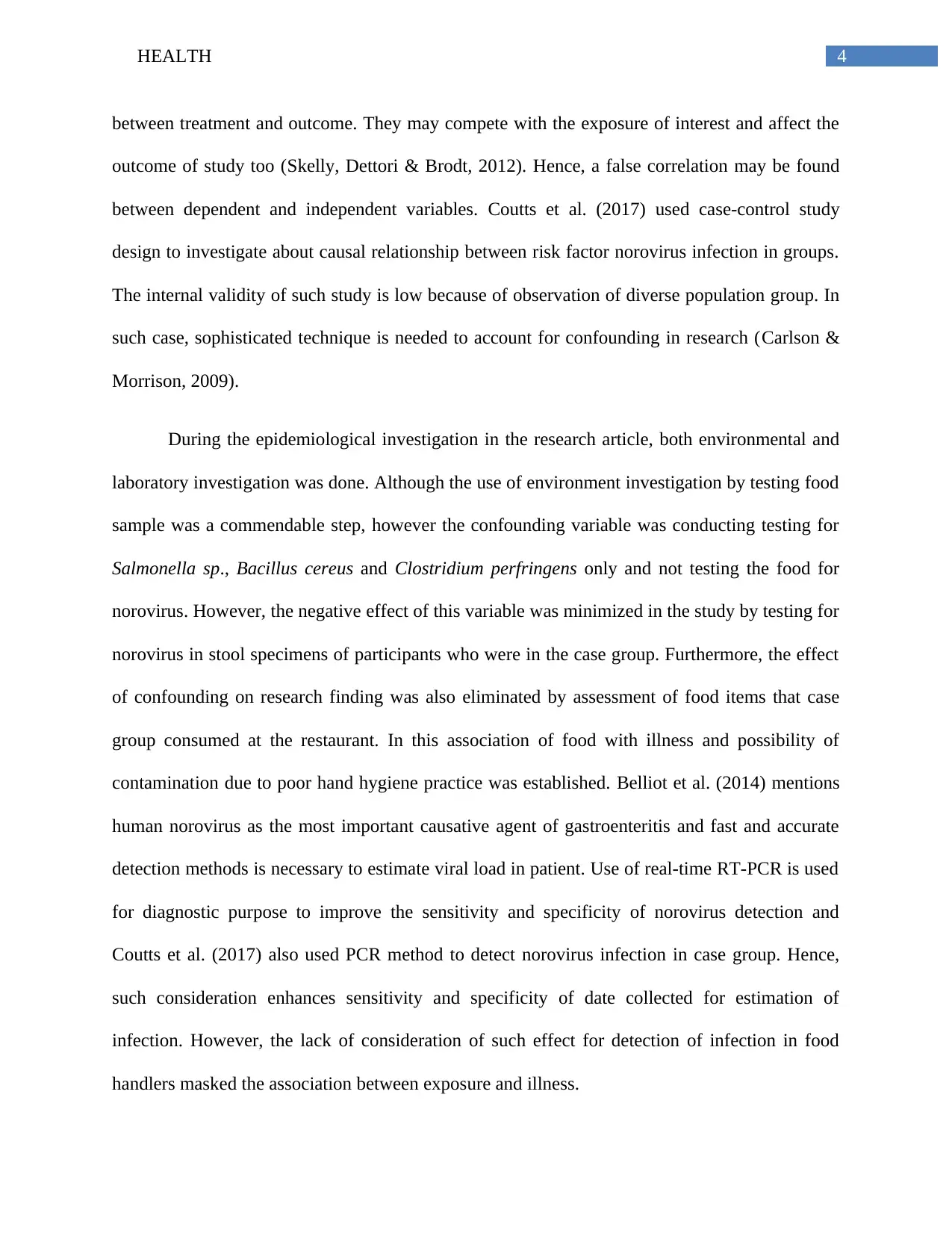
4HEALTH
between treatment and outcome. They may compete with the exposure of interest and affect the
outcome of study too (Skelly, Dettori & Brodt, 2012). Hence, a false correlation may be found
between dependent and independent variables. Coutts et al. (2017) used case-control study
design to investigate about causal relationship between risk factor norovirus infection in groups.
The internal validity of such study is low because of observation of diverse population group. In
such case, sophisticated technique is needed to account for confounding in research (Carlson &
Morrison, 2009).
During the epidemiological investigation in the research article, both environmental and
laboratory investigation was done. Although the use of environment investigation by testing food
sample was a commendable step, however the confounding variable was conducting testing for
Salmonella sp., Bacillus cereus and Clostridium perfringens only and not testing the food for
norovirus. However, the negative effect of this variable was minimized in the study by testing for
norovirus in stool specimens of participants who were in the case group. Furthermore, the effect
of confounding on research finding was also eliminated by assessment of food items that case
group consumed at the restaurant. In this association of food with illness and possibility of
contamination due to poor hand hygiene practice was established. Belliot et al. (2014) mentions
human norovirus as the most important causative agent of gastroenteritis and fast and accurate
detection methods is necessary to estimate viral load in patient. Use of real-time RT-PCR is used
for diagnostic purpose to improve the sensitivity and specificity of norovirus detection and
Coutts et al. (2017) also used PCR method to detect norovirus infection in case group. Hence,
such consideration enhances sensitivity and specificity of date collected for estimation of
infection. However, the lack of consideration of such effect for detection of infection in food
handlers masked the association between exposure and illness.
between treatment and outcome. They may compete with the exposure of interest and affect the
outcome of study too (Skelly, Dettori & Brodt, 2012). Hence, a false correlation may be found
between dependent and independent variables. Coutts et al. (2017) used case-control study
design to investigate about causal relationship between risk factor norovirus infection in groups.
The internal validity of such study is low because of observation of diverse population group. In
such case, sophisticated technique is needed to account for confounding in research (Carlson &
Morrison, 2009).
During the epidemiological investigation in the research article, both environmental and
laboratory investigation was done. Although the use of environment investigation by testing food
sample was a commendable step, however the confounding variable was conducting testing for
Salmonella sp., Bacillus cereus and Clostridium perfringens only and not testing the food for
norovirus. However, the negative effect of this variable was minimized in the study by testing for
norovirus in stool specimens of participants who were in the case group. Furthermore, the effect
of confounding on research finding was also eliminated by assessment of food items that case
group consumed at the restaurant. In this association of food with illness and possibility of
contamination due to poor hand hygiene practice was established. Belliot et al. (2014) mentions
human norovirus as the most important causative agent of gastroenteritis and fast and accurate
detection methods is necessary to estimate viral load in patient. Use of real-time RT-PCR is used
for diagnostic purpose to improve the sensitivity and specificity of norovirus detection and
Coutts et al. (2017) also used PCR method to detect norovirus infection in case group. Hence,
such consideration enhances sensitivity and specificity of date collected for estimation of
infection. However, the lack of consideration of such effect for detection of infection in food
handlers masked the association between exposure and illness.

5HEALTH
While critically appraising a research article, assessment of the role of bias in research
finding is necessary to understand the precision of research. Researchers must consider source of
bias in studies to diminish their impact on results. This enhances the possibility of finding a true
effect and making accurate estimation regarding exposure and outcome (Skelly, Dettori & Brodt,
2012).. The first type of bias that can be found in the study is selection bias. This may result
because of inappropriate selection of research sample representative of the population intended
to be analyzed (Yin, 2017). The bias in terms of selection bias is missing in the study by Coutts
et al. (2017) as research was done in compliance with case control study protocol. The study had
a case group with exposure and a control group without exposure. The method of sample
recruitment and the case definition to recruit participants eliminated any chances of selection
bias. The study had a retrospective design which aimed to evaluate past exposure. To enhance
the internal validity, research must consider about recall bias. This is necessary because cases are
more likely to recall past exposure (Carlson & Morrison, 2009). However, this consideration was
not done and recall bias reduced the internal validity of the study. There was a need to eliminate
recall bias particularly when large numbers of food choices were analyzed in the study.
Discussion regarding causal relationship
To investigate the quality of research evidence in terms of causal relationship, the use of
Bradford Hill criteria is beneficial. The Bradford Hill Criteria is a group of 9 principles that helps
in establishing evidence of a causal relationship between a cause and observed effect. The list of
criteria and evaluation of the study by Coutts et al. (2017) in terms of those criteria are as
follows:
While critically appraising a research article, assessment of the role of bias in research
finding is necessary to understand the precision of research. Researchers must consider source of
bias in studies to diminish their impact on results. This enhances the possibility of finding a true
effect and making accurate estimation regarding exposure and outcome (Skelly, Dettori & Brodt,
2012).. The first type of bias that can be found in the study is selection bias. This may result
because of inappropriate selection of research sample representative of the population intended
to be analyzed (Yin, 2017). The bias in terms of selection bias is missing in the study by Coutts
et al. (2017) as research was done in compliance with case control study protocol. The study had
a case group with exposure and a control group without exposure. The method of sample
recruitment and the case definition to recruit participants eliminated any chances of selection
bias. The study had a retrospective design which aimed to evaluate past exposure. To enhance
the internal validity, research must consider about recall bias. This is necessary because cases are
more likely to recall past exposure (Carlson & Morrison, 2009). However, this consideration was
not done and recall bias reduced the internal validity of the study. There was a need to eliminate
recall bias particularly when large numbers of food choices were analyzed in the study.
Discussion regarding causal relationship
To investigate the quality of research evidence in terms of causal relationship, the use of
Bradford Hill criteria is beneficial. The Bradford Hill Criteria is a group of 9 principles that helps
in establishing evidence of a causal relationship between a cause and observed effect. The list of
criteria and evaluation of the study by Coutts et al. (2017) in terms of those criteria are as
follows:
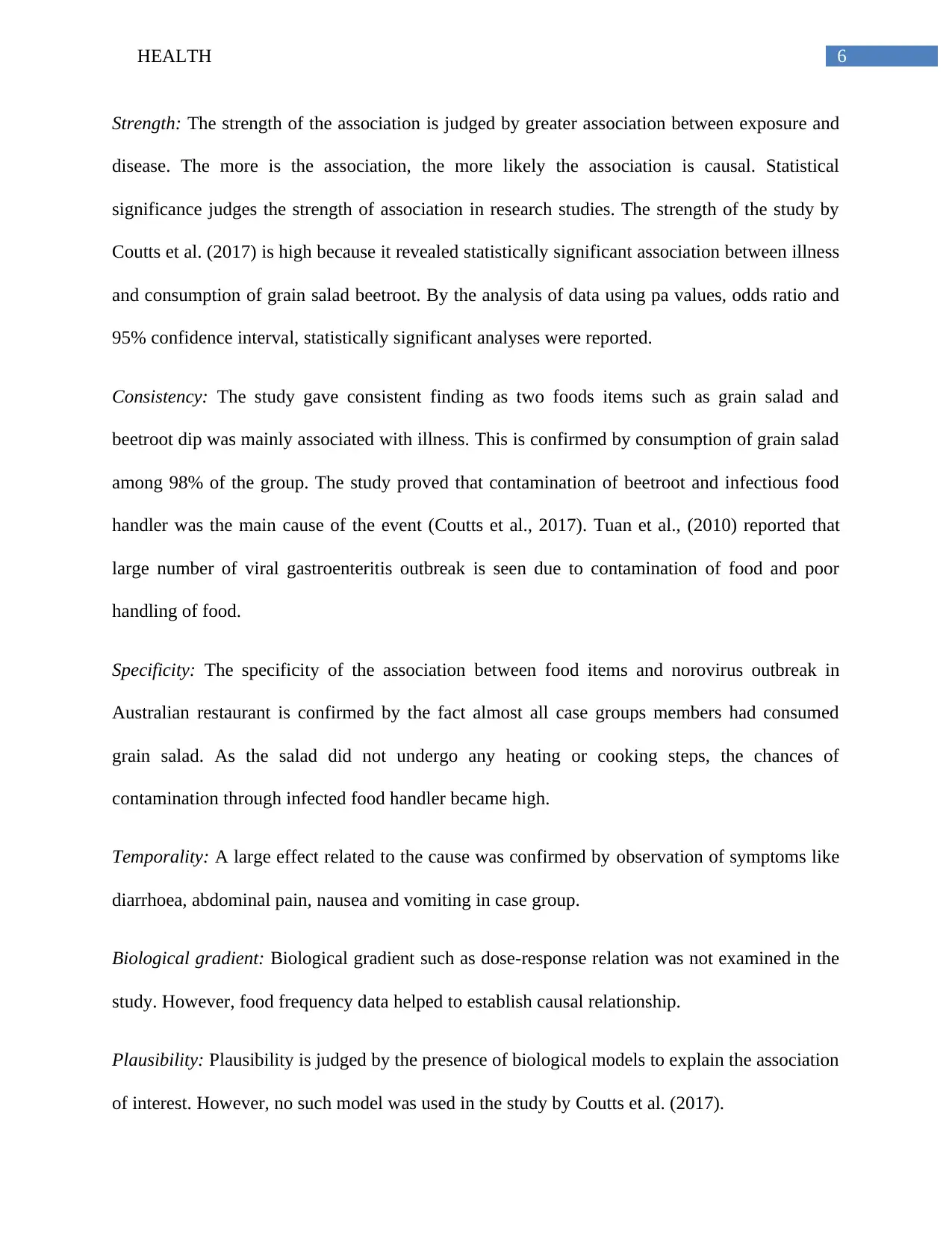
6HEALTH
Strength: The strength of the association is judged by greater association between exposure and
disease. The more is the association, the more likely the association is causal. Statistical
significance judges the strength of association in research studies. The strength of the study by
Coutts et al. (2017) is high because it revealed statistically significant association between illness
and consumption of grain salad beetroot. By the analysis of data using pa values, odds ratio and
95% confidence interval, statistically significant analyses were reported.
Consistency: The study gave consistent finding as two foods items such as grain salad and
beetroot dip was mainly associated with illness. This is confirmed by consumption of grain salad
among 98% of the group. The study proved that contamination of beetroot and infectious food
handler was the main cause of the event (Coutts et al., 2017). Tuan et al., (2010) reported that
large number of viral gastroenteritis outbreak is seen due to contamination of food and poor
handling of food.
Specificity: The specificity of the association between food items and norovirus outbreak in
Australian restaurant is confirmed by the fact almost all case groups members had consumed
grain salad. As the salad did not undergo any heating or cooking steps, the chances of
contamination through infected food handler became high.
Temporality: A large effect related to the cause was confirmed by observation of symptoms like
diarrhoea, abdominal pain, nausea and vomiting in case group.
Biological gradient: Biological gradient such as dose-response relation was not examined in the
study. However, food frequency data helped to establish causal relationship.
Plausibility: Plausibility is judged by the presence of biological models to explain the association
of interest. However, no such model was used in the study by Coutts et al. (2017).
Strength: The strength of the association is judged by greater association between exposure and
disease. The more is the association, the more likely the association is causal. Statistical
significance judges the strength of association in research studies. The strength of the study by
Coutts et al. (2017) is high because it revealed statistically significant association between illness
and consumption of grain salad beetroot. By the analysis of data using pa values, odds ratio and
95% confidence interval, statistically significant analyses were reported.
Consistency: The study gave consistent finding as two foods items such as grain salad and
beetroot dip was mainly associated with illness. This is confirmed by consumption of grain salad
among 98% of the group. The study proved that contamination of beetroot and infectious food
handler was the main cause of the event (Coutts et al., 2017). Tuan et al., (2010) reported that
large number of viral gastroenteritis outbreak is seen due to contamination of food and poor
handling of food.
Specificity: The specificity of the association between food items and norovirus outbreak in
Australian restaurant is confirmed by the fact almost all case groups members had consumed
grain salad. As the salad did not undergo any heating or cooking steps, the chances of
contamination through infected food handler became high.
Temporality: A large effect related to the cause was confirmed by observation of symptoms like
diarrhoea, abdominal pain, nausea and vomiting in case group.
Biological gradient: Biological gradient such as dose-response relation was not examined in the
study. However, food frequency data helped to establish causal relationship.
Plausibility: Plausibility is judged by the presence of biological models to explain the association
of interest. However, no such model was used in the study by Coutts et al. (2017).
Secure Best Marks with AI Grader
Need help grading? Try our AI Grader for instant feedback on your assignments.
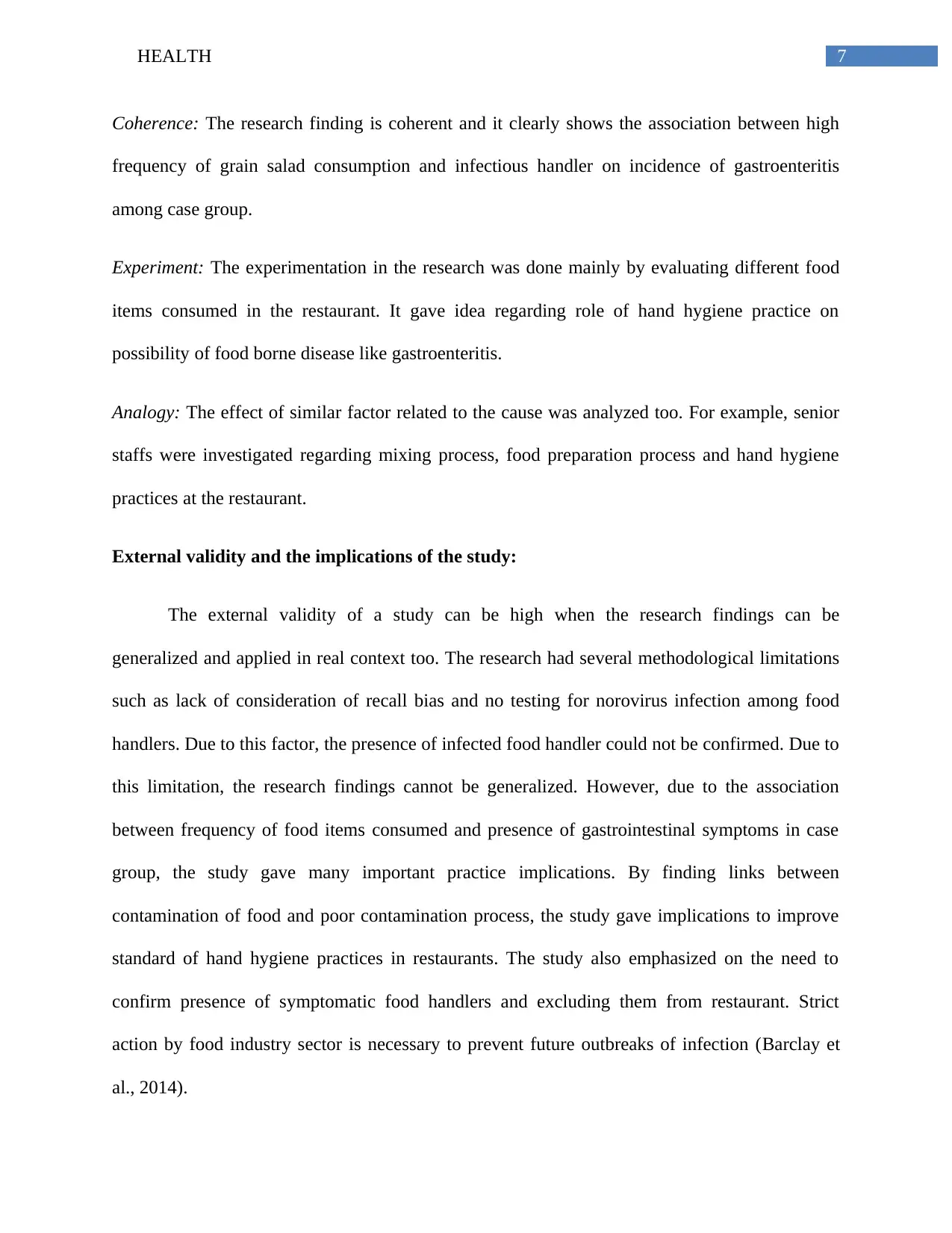
7HEALTH
Coherence: The research finding is coherent and it clearly shows the association between high
frequency of grain salad consumption and infectious handler on incidence of gastroenteritis
among case group.
Experiment: The experimentation in the research was done mainly by evaluating different food
items consumed in the restaurant. It gave idea regarding role of hand hygiene practice on
possibility of food borne disease like gastroenteritis.
Analogy: The effect of similar factor related to the cause was analyzed too. For example, senior
staffs were investigated regarding mixing process, food preparation process and hand hygiene
practices at the restaurant.
External validity and the implications of the study:
The external validity of a study can be high when the research findings can be
generalized and applied in real context too. The research had several methodological limitations
such as lack of consideration of recall bias and no testing for norovirus infection among food
handlers. Due to this factor, the presence of infected food handler could not be confirmed. Due to
this limitation, the research findings cannot be generalized. However, due to the association
between frequency of food items consumed and presence of gastrointestinal symptoms in case
group, the study gave many important practice implications. By finding links between
contamination of food and poor contamination process, the study gave implications to improve
standard of hand hygiene practices in restaurants. The study also emphasized on the need to
confirm presence of symptomatic food handlers and excluding them from restaurant. Strict
action by food industry sector is necessary to prevent future outbreaks of infection (Barclay et
al., 2014).
Coherence: The research finding is coherent and it clearly shows the association between high
frequency of grain salad consumption and infectious handler on incidence of gastroenteritis
among case group.
Experiment: The experimentation in the research was done mainly by evaluating different food
items consumed in the restaurant. It gave idea regarding role of hand hygiene practice on
possibility of food borne disease like gastroenteritis.
Analogy: The effect of similar factor related to the cause was analyzed too. For example, senior
staffs were investigated regarding mixing process, food preparation process and hand hygiene
practices at the restaurant.
External validity and the implications of the study:
The external validity of a study can be high when the research findings can be
generalized and applied in real context too. The research had several methodological limitations
such as lack of consideration of recall bias and no testing for norovirus infection among food
handlers. Due to this factor, the presence of infected food handler could not be confirmed. Due to
this limitation, the research findings cannot be generalized. However, due to the association
between frequency of food items consumed and presence of gastrointestinal symptoms in case
group, the study gave many important practice implications. By finding links between
contamination of food and poor contamination process, the study gave implications to improve
standard of hand hygiene practices in restaurants. The study also emphasized on the need to
confirm presence of symptomatic food handlers and excluding them from restaurant. Strict
action by food industry sector is necessary to prevent future outbreaks of infection (Barclay et
al., 2014).
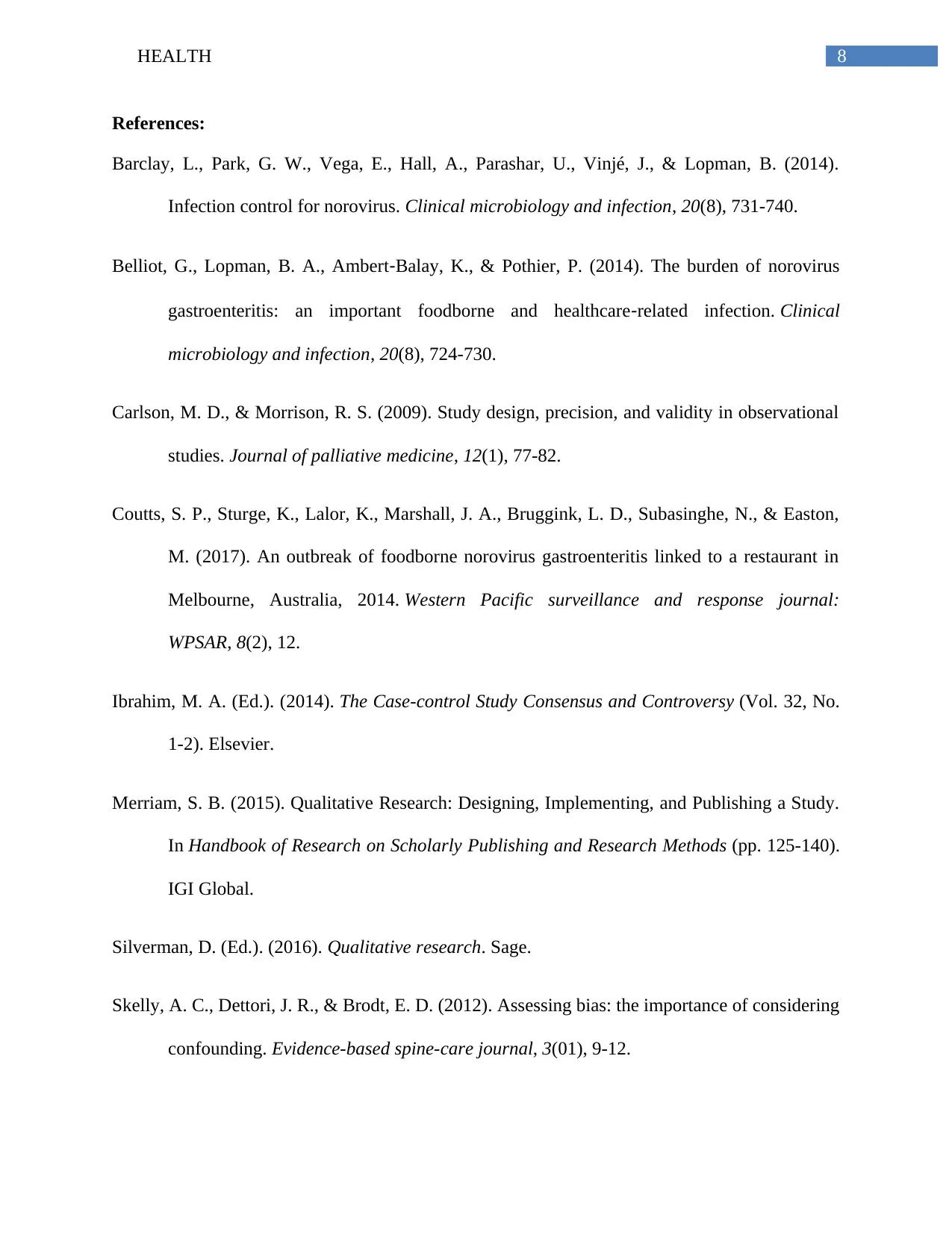
8HEALTH
References:
Barclay, L., Park, G. W., Vega, E., Hall, A., Parashar, U., Vinjé, J., & Lopman, B. (2014).
Infection control for norovirus. Clinical microbiology and infection, 20(8), 731-740.
Belliot, G., Lopman, B. A., Ambert‐Balay, K., & Pothier, P. (2014). The burden of norovirus
gastroenteritis: an important foodborne and healthcare‐related infection. Clinical
microbiology and infection, 20(8), 724-730.
Carlson, M. D., & Morrison, R. S. (2009). Study design, precision, and validity in observational
studies. Journal of palliative medicine, 12(1), 77-82.
Coutts, S. P., Sturge, K., Lalor, K., Marshall, J. A., Bruggink, L. D., Subasinghe, N., & Easton,
M. (2017). An outbreak of foodborne norovirus gastroenteritis linked to a restaurant in
Melbourne, Australia, 2014. Western Pacific surveillance and response journal:
WPSAR, 8(2), 12.
Ibrahim, M. A. (Ed.). (2014). The Case-control Study Consensus and Controversy (Vol. 32, No.
1-2). Elsevier.
Merriam, S. B. (2015). Qualitative Research: Designing, Implementing, and Publishing a Study.
In Handbook of Research on Scholarly Publishing and Research Methods (pp. 125-140).
IGI Global.
Silverman, D. (Ed.). (2016). Qualitative research. Sage.
Skelly, A. C., Dettori, J. R., & Brodt, E. D. (2012). Assessing bias: the importance of considering
confounding. Evidence-based spine-care journal, 3(01), 9-12.
References:
Barclay, L., Park, G. W., Vega, E., Hall, A., Parashar, U., Vinjé, J., & Lopman, B. (2014).
Infection control for norovirus. Clinical microbiology and infection, 20(8), 731-740.
Belliot, G., Lopman, B. A., Ambert‐Balay, K., & Pothier, P. (2014). The burden of norovirus
gastroenteritis: an important foodborne and healthcare‐related infection. Clinical
microbiology and infection, 20(8), 724-730.
Carlson, M. D., & Morrison, R. S. (2009). Study design, precision, and validity in observational
studies. Journal of palliative medicine, 12(1), 77-82.
Coutts, S. P., Sturge, K., Lalor, K., Marshall, J. A., Bruggink, L. D., Subasinghe, N., & Easton,
M. (2017). An outbreak of foodborne norovirus gastroenteritis linked to a restaurant in
Melbourne, Australia, 2014. Western Pacific surveillance and response journal:
WPSAR, 8(2), 12.
Ibrahim, M. A. (Ed.). (2014). The Case-control Study Consensus and Controversy (Vol. 32, No.
1-2). Elsevier.
Merriam, S. B. (2015). Qualitative Research: Designing, Implementing, and Publishing a Study.
In Handbook of Research on Scholarly Publishing and Research Methods (pp. 125-140).
IGI Global.
Silverman, D. (Ed.). (2016). Qualitative research. Sage.
Skelly, A. C., Dettori, J. R., & Brodt, E. D. (2012). Assessing bias: the importance of considering
confounding. Evidence-based spine-care journal, 3(01), 9-12.
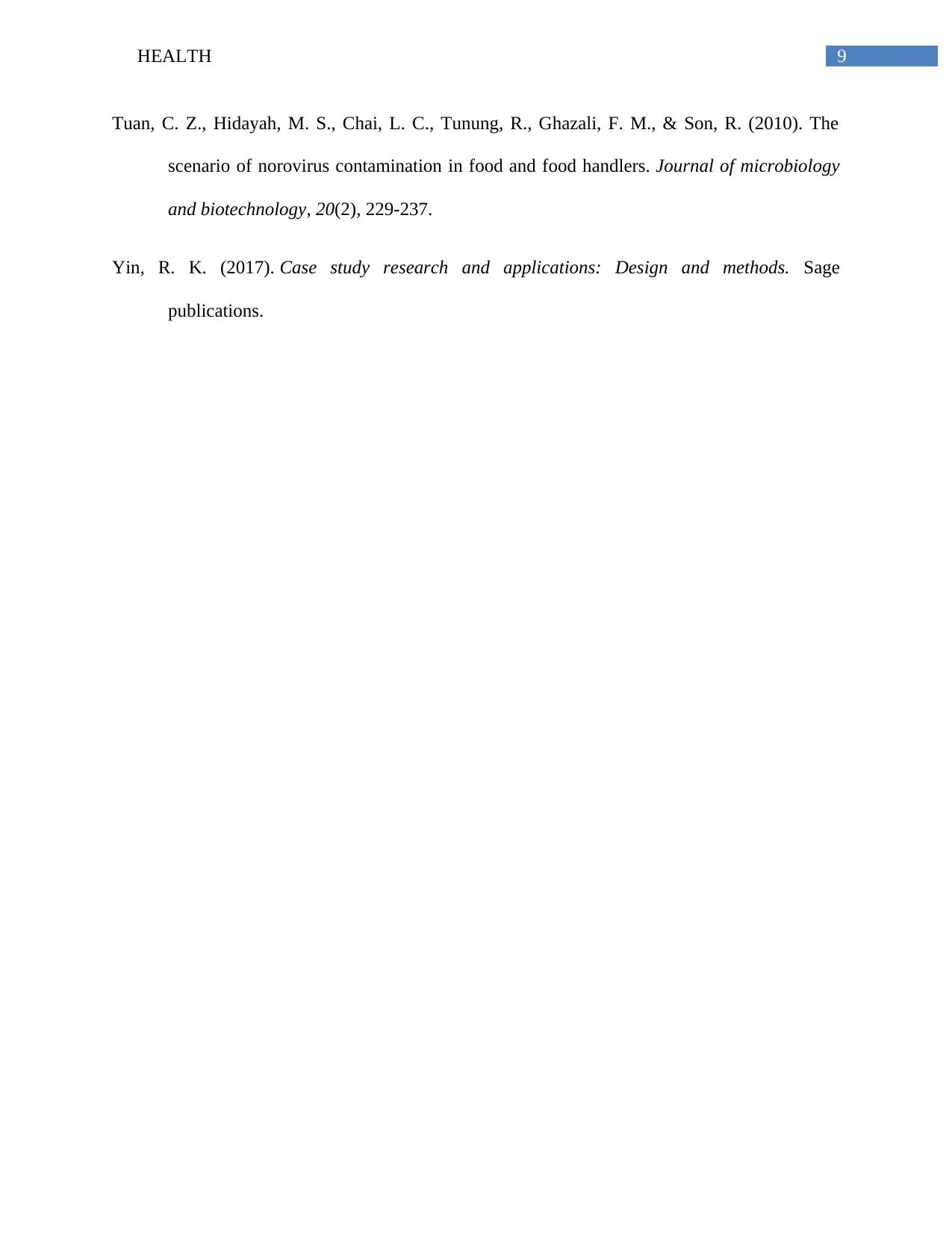
9HEALTH
Tuan, C. Z., Hidayah, M. S., Chai, L. C., Tunung, R., Ghazali, F. M., & Son, R. (2010). The
scenario of norovirus contamination in food and food handlers. Journal of microbiology
and biotechnology, 20(2), 229-237.
Yin, R. K. (2017). Case study research and applications: Design and methods. Sage
publications.
Tuan, C. Z., Hidayah, M. S., Chai, L. C., Tunung, R., Ghazali, F. M., & Son, R. (2010). The
scenario of norovirus contamination in food and food handlers. Journal of microbiology
and biotechnology, 20(2), 229-237.
Yin, R. K. (2017). Case study research and applications: Design and methods. Sage
publications.
1 out of 10
![[object Object]](/_next/static/media/star-bottom.7253800d.svg)




